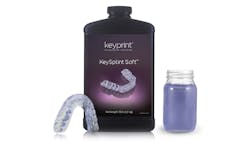Pearls for Your Practice: KeySplint Soft 3-D printing resin by Keyprint
Many dentists are adding 3-D printers to their practice’s technology suite. Obviously, investing in any technology for a business is reliant on generating a return on that investment. To get a return, we must be able to use the technology for as many applications as possible.
For most of us, 3-D printing in the dental office started with printing models from digital scans. Because companies have been producing new resins, we have seen an increase in applications for 3-D printing in the dental office in order to maximize returns. One of those new additions is printing occlusal splints in the office with my SprintRay 3D printer and KeySplint Soft resin.
KeySplint Soft is a 3-D printing resin approved by the US Food and Drug Administration for occlusal splints and night guards. It is fully biocompatible and complies with international medical device regulations and standards. It works with many different 3-D printers, including my SprintRay Pro.
Once printed, splints and guards with KeySplint Soft are tough and durable, while having a little give for patient comfort. Printing a traditional night guard takes about 7 to 10 ml of resin. This keeps the average cost to print a splint around $4. When compared with an average lab fee of over $100, you can see the opportunity for tremendous savings, even after the cost of the printer and associated time.
One barrier in printing guards and splints is designing them. You (or a team member) will either need to design them yourself in software such as Exocad or 3Shape, or have a lab or design service do this for you. I will be reviewing a design service soon, so watch for that! Apart from owning a 3-D printer, design is probably the biggest hurdle.
Once you secure a good design service, you will be ready to print your splint. Printing an average splint takes around 75 minutes on my SprintRay printer. Once printed, you will need to soak the splint in isopropyl alcohol for 5 to 10 minutes, then place the splint in a postcure unit. For a 3-D printed appliance to be used in the mouth, it must be postcured. This will eliminate all the uncured monomer left over from the printing process and make it safe to use intraorally. Pro Cure by SprintRay is the postcure unit I recommend.
Now that we have a printed, cleaned, and cured splint, it is time to polish. Keyprint has a published polishing protocol for this material. It takes about 15 minutes and will require a lab handpiece and a lathe. This task should be delegated to a dental assistant. Once polished, your printed splint is ready to be delivered, just as a traditional splint would be.
I have found these splints to be easy to deliver and well accepted by patients. Patients are reporting to me that they are very comfortable to wear! KeySplint Soft splints printed in your office are a great addition to your 3-D printing setup and add tremendous value to your practice. Line drive base hit to center field for Keyprint!
About the Author
Joshua Austin, DDS, MAGD
Joshua Austin, DDS, MAGD, is a graduate and former faculty member of the University of Texas Health Science Center at San Antonio School of Dentistry. Author of Dental Economics’ Pearls for Your Practice column, Dr. Austin lectures nationally on products, dental technology, online reputation management, and social media. He maintains a full-time restorative dentistry private practice in San Antonio, Texas. You may contact Dr. Austin at [email protected].
Updated June 21, 2023

